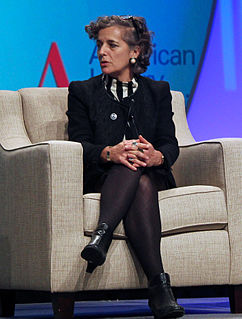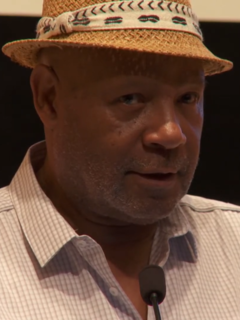Related Research Articles

An illustration is a decoration, interpretation or visual explanation of a text, concept or process, designed for integration in print and digital published media, such as posters, flyers, magazines, books, teaching materials, animations, video games and films. An illustration is typically created by an illustrator. Digital illustrations are often used to make websites and apps more user-friendly, such as the use of emojis to accompany digital type. llustration also means providing an example; either in writing or in picture form.

Raw was a comics anthology edited by Art Spiegelman and Françoise Mouly and published in the United States by Mouly from 1980 to 1991. It was a flagship publication of the 1980s alternative comics movement, serving as a more intellectual counterpoint to Robert Crumb's visceral Weirdo, which followed squarely in the underground tradition of Zap and Arcade. Along with the more genre-oriented Heavy Metal it was also one of the main venues for European comics in the United States in its day.
Arthur Paul was an American graphic designer and the founding art director of Playboy magazine. During his time at Playboy, he commissioned illustrators and artists, including Andy Warhol, Salvador Dalí, and James Rosenquist, as part of the illustration liberation movement.

Richard Bassford is an American illustrator who has worked in both advertising and comic books.

World War 3 Illustrated is an American comics anthology magazine with a left-wing political focus, founded in 1979 by New York City comic book artists Peter Kuper and Seth Tobocman, and painter Christof Kohlhofer, and subsequently produced by a collective with a rotating editorship. Other frequent contributors, mostly based in New York City, include Isabella Bannerman, Sue Coe, Scott Cunningham, Eric Drooker, Sandy Jimenez, Sabrina Jones, Mac McGill, Kevin Pyle, and James Romberger.
Sue Coe is an English artist and illustrator working primarily in drawing, printmaking, and in the form of illustrated books and comics. Her work is in the tradition of social protest art and is highly political. Coe's work often includes animal rights commentary, though she also creates work that centralizes the rights of marginalized peoples and criticizes capitalism. Her commentary on political events and social injustice are published in newspapers, magazines and books. Her work has been shown internationally in both solo and group exhibitions and has been collected by various international museums. She lives in Upstate New York.
Robert Weaver was an American illustrator. He was considered a pioneer of a contemporary approach to the field that began in the 1950s. Beginning in 1952, he embarked on a mission to combine the visual ideas found in fine art with the responsibility of journalist. At the time, many practitioners of illustration were expected to paint and draw for advertising and magazine assignments with artwork that was conservative, idealized and saccharine, while other illustrators such as Ronald Searle, Arthur Szyk, George Grosz, Kathe Kollwitz and later Ralph Steadman and Tomi Ungerer injected their own opinion into the matter. Weaver joined this latter tradition by moving his role of an illustrator from a page decorator to a journalist. He ventured from the typical haven of an illustrator's studio into the world and used a pencil to observe, record facts, and draw real life based visual essays, the way that illustrators such as Burt Silverman and Franklin McMahon did. This approach would later be termed "visual journalism" and in 1983 would form the basis of a special master's degree, Illustration as Visual Essay, from the School of Visual Arts in New York.

Françoise Mouly is a Paris-born New York-based designer, editor, and publisher. She is best known as co-founder, co-editor, and publisher of the comics and graphics magazine Raw (1980–1991), as the publisher of Raw Books and Toon Books, and since 1993 as the art editor of The New Yorker. Mouly is married to cartoonist Art Spiegelman, and is the mother of writer Nadja Spiegelman.

Andrice Arp is a U.S. comics artist and illustrator, and the daughter of Halton Arp. She has been a contributor to the self-published comic Hi-Horse. In 2004, Hi-Horse Omnibus, comprising all new material, was published by Alternative Comics. Arp also contributed to the comics anthology Mome.
Brad Holland is an American artist. His work has appeared in Time, Vanity Fair, The New Yorker, Playboy, Rolling Stone, The New York Times, and many other national and international publications. His paintings have been exhibited in museums around the world, including one-man exhibitions at the Musée des Beaux-Arts, Clermont-Ferrand, France and the Museum of American Illustration, New York City.
Anita E. Kunz, OC, DFA, RCA is a Canadian-born artist and illustrator. She was the first woman and first Canadian to have a solo exhibit at the Library of Congress in Washington, D.C.

Harry Fenn was an English-born American illustrator, landscape painter, etcher, and wood engraver. From 1870 to around 1895 he was the most prominent landscape illustrator in the United States. He is also noted for his illustrations of Egypt, Palestine and the Sinai.

Emory Douglas is an American graphic artist. He was a member of the Black Panther Party from 1967 until the Party disbanded in the 1980s. As a revolutionary artist and the Minister of Culture for the Black Panther Party, Douglas created iconography to represent black-American oppression.
Clara Elsene Peck was an American illustrator and painter known for her illustrations of women and children in the early 20th century. Peck received her arts education from the Minneapolis School of Fine Arts and was employed as a magazine illustrator from 1906 to 1940. Peck's body of work encompasses a wide range, from popular women's magazines and children's books, works of fiction, commercial art for products like Ivory soap, and comic books and watercolor painting later in her career. Peck worked during the "Golden Age of American Illustration" (1880s–1930s) contemporaneous with noted female illustrators Jessie Willcox Smith, Elizabeth Shippen Green and Violet Oakley.

Lorraine Fox (1922–1976) was an American illustrator and commercial artist who illustrated magazines, book covers, and advertisements. Among the magazines she illustrated for were Woman's Day, Good Housekeeping, Redbook, McCall's, and Cosmopolitan. She was inducted into the Society of Illustrators' Hall of Fame in 1979.

Nova was a British glossy magazine that was published from March 1965 to October 1975 It was described by The Times as "a politically radical, beautifully designed, intellectual women's magazine." Nova covered once-taboo subjects as abortion, cancer, the birth control pill, race, homosexuality, divorce and royal affairs. It featured stylish and provocative cover images.
Barry Blitt is an American artist.
Tom Bachtell is a self-taught artist who is an illustrator and caricaturist for The New Yorker's Talk of the Town as well as other sections, contributing regularly for 23 years. He has done work for Entertainment Weekly, Newsweek, Forbes, Bon Appétit, Town & Country, Mother Jones, New York, Poetry, the New York Times, the Wall Street Journal, the New York Observer and London's Evening Standard as well as Marshall Field, Lands' End and the chamber-music series at the University of Chicago as part of his ad-campaign clientele. His brush-and-ink style is considered to be reminiscent of American cartoonists from the 1920s and 1930s. He was a finalist for the 18th Lambda Literary Awards as illustrator along with editor Robert Trachtenberg for the book When I Knew under the Belles Lettres category.
Stewart Mackinnon is a Scottish film and television producer, founder and former CEO of Headline Pictures. He produced the film Quartet, the international Emmy winning television film Peter And Wendy, and the Amazon Studios series The Man in the High Castle. In 2020, he founded Circle Pictures.

Kirsten Ulve is a graphic artist who resides in New York City. She is best known for her caricatures of notable people and editorial illustration for newspapers and magazines. Ulve has also designed for an array of other mediums including a marquee for Broadway and stamps for the United States Post Office. Kirsten is married to WFMU radio personality Clay Pigeon.
References
- 1 2 "The Association of Illustrators". AOI. Retrieved 17 September 2011.
- ↑ Sue, Coe. Contemporary British illustration. Institute of Contemporary Arts. p. 29. ISBN 978-0-905263-60-1.
- ↑ "Frieze Magazine: Illustrate This". Frieze Magazine. Retrieved 18 September 2011.
- ↑ "Andrzej Klimowski: Theatre of dreams". Eye. Retrieved 18 September 2011.
- ↑ Rick, Poynor. "Stewart Mackinnon: Ruptured and Remade" . Retrieved 17 September 2011.